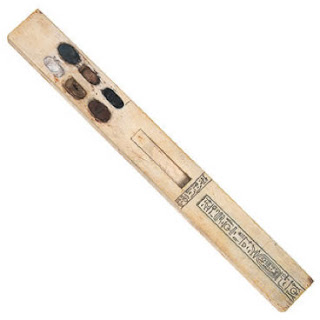Translate
Wednesday, December 22, 2010
National Park Service
Collections
Prehistoric and historic objects and places help us understand the world and our place in it. They connect us to the past, but they can also connect us to the present and each other. The National Park Service cares for some of the largest and most diverse natural and cultural history collections in the world. It also keeps records and lists of our most treasured historic places.



Virtual Exhibits link here.
Museum Management Program link here.
Prehistoric and historic objects and places help us understand the world and our place in it. They connect us to the past, but they can also connect us to the present and each other. The National Park Service cares for some of the largest and most diverse natural and cultural history collections in the world. It also keeps records and lists of our most treasured historic places.



Virtual Exhibits link here.
Museum Management Program link here.
Tuesday, December 21, 2010
Art History Newsletter
The Art History Newsletter
Subscribe | Search:
WHEN DID SEEING BECOME BELIEVING?
by Jon Lackman | 15 November 2010 | Books, Medieval
Roland Recht’s 1999 book Believing and seeing. The art of Gothic cathedrals has finally been published in English, in a translation by the late Mary Writtall.
In the July 2010 issue of Metascience Ellen M. Shortell writes:
Studies in medieval religion, science, literature, and art, particularly in the past two decades, have focused a great deal of attention on the role of vision in later medieval thought. It is clear that by the year 1200, Richard of St. Victor’s “simple perception of matter” was no longer simple, but was recognised by many as a means to the understanding of profound truths … Recent scholarship on Gothic art and architecture has in fact been interested in related themes—the interrelationship of architectural space, colour, light, and figural imagery; the viewer’s experience of religious buildings; the visual and material properties of medieval art and their relationship to spirituality. Where most studies that aim for an integration of media have focused on specific sites, however, Recht casts his eye more broadly on the phenomenon of Gothic … [T]he book reads more as a wide-ranging compendium of observations gleaned over the course of a distinguished career than as the sustained, in-depth thesis on visual culture that the title suggests …
Recht is convincing when he argues that architects and other artists must have been conscious of the effects of their invention. He suggests that master masons began to invent new forms to fulfill their clerical patrons’ requests, thus gaining greater respect and developing a new sense of their own powers; the Gothic cathedrals could not have come into being without a community of artists who communicated with one another and began to see themselves in a new light. These ideas are extended to sculptors and painters of the fourteenth and, especially, fifteenth centuries in the final chapters of the book.
In the preface to the French edition, the author expressed the wish that this book be seen as a contribution to the history of ideas as much as to the history of visual art, and that colleagues recognise the value of cross-disciplinary approaches. The scope of the undertaking is ambitious, and observations from the well-trained eye of a distinguished scholar are often tantalizing.
In Times Higher Education, Caroline Bruzelius writes:
This book … is an ambitious, broad-ranging study of the role and function of the image within the medieval church … [Recht] brings together two subjects that are usually studied separately, architecture and sacred images, and he proposes that the latter cannot be understood or experienced without the former, in both spatial and liturgical terms … The second part of the volume focuses on the modes of viewing religious images in relation to the “theatre” of the Mass and as active forces in lay piety. Here there are many important insights, not least of which is the enhanced sacralisation of liturgical space after the promulgation of the doctrine of transubstantiation – that is to say, the real presence of Christ at the altar during the Elevation of the Host … Recht’s analysis of sacred images as mnemonic devices that engage vision as an active force in a spiritual journey is deeply compelling, and he presents new and powerful interpretations of how sacred space conditioned and participated in a larger system of signification of the image … No one knows better than Recht that church spaces were not the open spaces we see today, but instead partitioned into distinct zones, access to which was conditioned by gender, lay or clerical status, or other systems of separation and power … Visual access to the sacred may have been as much an instrument of power and authority as a communally shared experience.
In The Medieval Review, Charlotte A. Stanford lauds “this translation of a complex study by a noted European art historian”:
[Recht] employed his keen eye and pen in mingling historiography and analysis to explore the phenomenon of Gothic throughout Europe … One of Recht’s greatest strengths as a scholar in this study is his own connoisseur’s eye, especially as he discusses the manipulation of architectural space. These sections are heavy with specialized, but necessary terminology. A case in point is his discussion of the torus moldings on the arch openings of each level of the nave of Sens cathedral, required for explaining how the rich juxtaposition of light and shadow was formed at Sens … In keeping with the title, however, the book’s main thrust is to examine the cathedral as a mingled system of seeing and belief … This system revolves, Recht argues, around an increasing desire to provide eyewitness proof of the miraculous through depictions of the lives of saints and the mystery of the Host … [Cathedrals] paved the way for the development of illusionistic space in Quattrocento painting [he argues]. This concluding claim is bold and thought provoking … Nevertheless, Recht’s book must be treated with caution: it is not a general introduction either to cathedrals or ways of seeing … [It] is ultimately, despite its weaknesses, an intriguing study of Gothic accompanied by investigation of many critical questions in the discipline, written by an observant and thoughtful scholar and now made easily accessible to the English-speaking world.
In the Journal of Ecclesiastical History, Paul Binski writes:
Recht’s study can now be seen as part of a trend towards the study of visuality which emerged in the 1980s and 1990s, and which entailed a broader enquiry into the hierarchy of the senses and epistemology. As an hypothesis about actual historical change it raises several questions … The strength of Recht’s book is its practical engagement with art and architecture especially. It has useful, if rather distended, opening sections on the history of the modern reception and interpretation of Gothic cathedrals.
Subscribe | Search:
WHEN DID SEEING BECOME BELIEVING?
by Jon Lackman | 15 November 2010 | Books, Medieval
Roland Recht’s 1999 book Believing and seeing. The art of Gothic cathedrals has finally been published in English, in a translation by the late Mary Writtall.
In the July 2010 issue of Metascience Ellen M. Shortell writes:
Studies in medieval religion, science, literature, and art, particularly in the past two decades, have focused a great deal of attention on the role of vision in later medieval thought. It is clear that by the year 1200, Richard of St. Victor’s “simple perception of matter” was no longer simple, but was recognised by many as a means to the understanding of profound truths … Recent scholarship on Gothic art and architecture has in fact been interested in related themes—the interrelationship of architectural space, colour, light, and figural imagery; the viewer’s experience of religious buildings; the visual and material properties of medieval art and their relationship to spirituality. Where most studies that aim for an integration of media have focused on specific sites, however, Recht casts his eye more broadly on the phenomenon of Gothic … [T]he book reads more as a wide-ranging compendium of observations gleaned over the course of a distinguished career than as the sustained, in-depth thesis on visual culture that the title suggests …
Recht is convincing when he argues that architects and other artists must have been conscious of the effects of their invention. He suggests that master masons began to invent new forms to fulfill their clerical patrons’ requests, thus gaining greater respect and developing a new sense of their own powers; the Gothic cathedrals could not have come into being without a community of artists who communicated with one another and began to see themselves in a new light. These ideas are extended to sculptors and painters of the fourteenth and, especially, fifteenth centuries in the final chapters of the book.
In the preface to the French edition, the author expressed the wish that this book be seen as a contribution to the history of ideas as much as to the history of visual art, and that colleagues recognise the value of cross-disciplinary approaches. The scope of the undertaking is ambitious, and observations from the well-trained eye of a distinguished scholar are often tantalizing.
In Times Higher Education, Caroline Bruzelius writes:
This book … is an ambitious, broad-ranging study of the role and function of the image within the medieval church … [Recht] brings together two subjects that are usually studied separately, architecture and sacred images, and he proposes that the latter cannot be understood or experienced without the former, in both spatial and liturgical terms … The second part of the volume focuses on the modes of viewing religious images in relation to the “theatre” of the Mass and as active forces in lay piety. Here there are many important insights, not least of which is the enhanced sacralisation of liturgical space after the promulgation of the doctrine of transubstantiation – that is to say, the real presence of Christ at the altar during the Elevation of the Host … Recht’s analysis of sacred images as mnemonic devices that engage vision as an active force in a spiritual journey is deeply compelling, and he presents new and powerful interpretations of how sacred space conditioned and participated in a larger system of signification of the image … No one knows better than Recht that church spaces were not the open spaces we see today, but instead partitioned into distinct zones, access to which was conditioned by gender, lay or clerical status, or other systems of separation and power … Visual access to the sacred may have been as much an instrument of power and authority as a communally shared experience.
In The Medieval Review, Charlotte A. Stanford lauds “this translation of a complex study by a noted European art historian”:
[Recht] employed his keen eye and pen in mingling historiography and analysis to explore the phenomenon of Gothic throughout Europe … One of Recht’s greatest strengths as a scholar in this study is his own connoisseur’s eye, especially as he discusses the manipulation of architectural space. These sections are heavy with specialized, but necessary terminology. A case in point is his discussion of the torus moldings on the arch openings of each level of the nave of Sens cathedral, required for explaining how the rich juxtaposition of light and shadow was formed at Sens … In keeping with the title, however, the book’s main thrust is to examine the cathedral as a mingled system of seeing and belief … This system revolves, Recht argues, around an increasing desire to provide eyewitness proof of the miraculous through depictions of the lives of saints and the mystery of the Host … [Cathedrals] paved the way for the development of illusionistic space in Quattrocento painting [he argues]. This concluding claim is bold and thought provoking … Nevertheless, Recht’s book must be treated with caution: it is not a general introduction either to cathedrals or ways of seeing … [It] is ultimately, despite its weaknesses, an intriguing study of Gothic accompanied by investigation of many critical questions in the discipline, written by an observant and thoughtful scholar and now made easily accessible to the English-speaking world.
In the Journal of Ecclesiastical History, Paul Binski writes:
Recht’s study can now be seen as part of a trend towards the study of visuality which emerged in the 1980s and 1990s, and which entailed a broader enquiry into the hierarchy of the senses and epistemology. As an hypothesis about actual historical change it raises several questions … The strength of Recht’s book is its practical engagement with art and architecture especially. It has useful, if rather distended, opening sections on the history of the modern reception and interpretation of Gothic cathedrals.
Art History Newsletter
The Art History Newsletter
Subscribe | Search:
BRUNELLESCHI’S EGG
by Jon Lackman | 1 December 2010 | Renaissance
In the Spring/Summer 2010 issue of Woman’s Art Journal, the editors write:
Even with the rising presence of art by women in museums and on bookstore shelves, Woman’s Art Journal continues to find a receptive audience for its mission: recognition of women artists of the past and present. From the overwhelming number of books and submissions we receive, it’s clear that interest in research in our field is also on the rise … [T]he number of unsolicited manuscripts we’ve received in the last year has more than tripled.
Pioneering feminist Mary D. Garrard (who was celebrated alongside Norma Broude at the First Annual Feminist Art History Conference at American University) has a hefty new book out, Brunelleschi’s Egg, which examines how the Renaissance “shift in the concept of nature–from an organic worldview to the scientific–was assisted by the gender metaphor that defined nature as female … [and] was both anticipated and mediated by the visual arts.” Garrard separates artists into two camps – those who “claimed to rival and defeat female nature” and for whom “art and nature are more often seen as collaborative partners.”
The book’s title refers to a story Vasari told about Brunelleschi balancing an egg on its narrow end, as well as the venerable but seldom believed notion that Brunelleschi might have borrowed the shape of his Florentine dome from an egg:
Brunelleschi makes the egg perform for him, putting it to larger use by imitating Nature’s mysterious designs on a grand scale. The concealment of his sources, both in the apparently cryptic egg demonstration and in the hiding of the dome’s true structure behind ribs that tectonized its breast- or egglike form, may bespeak an unacknowledged competition, between the creative powers of Nature and those of the artist. At this stage, art’s special powers are not articulated directly, and Nature is still credited as their source – as we saw in Alberti’s recommendation that architects follow “Nature’s ingenuity” and her biological order in their vault designs.
Subscribe | Search:
BRUNELLESCHI’S EGG
by Jon Lackman | 1 December 2010 | Renaissance
In the Spring/Summer 2010 issue of Woman’s Art Journal, the editors write:
Even with the rising presence of art by women in museums and on bookstore shelves, Woman’s Art Journal continues to find a receptive audience for its mission: recognition of women artists of the past and present. From the overwhelming number of books and submissions we receive, it’s clear that interest in research in our field is also on the rise … [T]he number of unsolicited manuscripts we’ve received in the last year has more than tripled.
Pioneering feminist Mary D. Garrard (who was celebrated alongside Norma Broude at the First Annual Feminist Art History Conference at American University) has a hefty new book out, Brunelleschi’s Egg, which examines how the Renaissance “shift in the concept of nature–from an organic worldview to the scientific–was assisted by the gender metaphor that defined nature as female … [and] was both anticipated and mediated by the visual arts.” Garrard separates artists into two camps – those who “claimed to rival and defeat female nature” and for whom “art and nature are more often seen as collaborative partners.”
The book’s title refers to a story Vasari told about Brunelleschi balancing an egg on its narrow end, as well as the venerable but seldom believed notion that Brunelleschi might have borrowed the shape of his Florentine dome from an egg:
Brunelleschi makes the egg perform for him, putting it to larger use by imitating Nature’s mysterious designs on a grand scale. The concealment of his sources, both in the apparently cryptic egg demonstration and in the hiding of the dome’s true structure behind ribs that tectonized its breast- or egglike form, may bespeak an unacknowledged competition, between the creative powers of Nature and those of the artist. At this stage, art’s special powers are not articulated directly, and Nature is still credited as their source – as we saw in Alberti’s recommendation that architects follow “Nature’s ingenuity” and her biological order in their vault designs.
The Art History Newsletter
The Art History Newsletter
Subscribe | Search:
BRUNELLESCHI’S EGG
by Jon Lackman | 1 December 2010 | Renaissance
In the Spring/Summer 2010 issue of Woman’s Art Journal, the editors write:
Even with the rising presence of art by women in museums and on bookstore shelves, Woman’s Art Journal continues to find a receptive audience for its mission: recognition of women artists of the past and present. From the overwhelming number of books and submissions we receive, it’s clear that interest in research in our field is also on the rise … [T]he number of unsolicited manuscripts we’ve received in the last year has more than tripled.
Pioneering feminist Mary D. Garrard (who was celebrated alongside Norma Broude at the First Annual Feminist Art History Conference at American University) has a hefty new book out, Brunelleschi’s Egg, which examines how the Renaissance “shift in the concept of nature–from an organic worldview to the scientific–was assisted by the gender metaphor that defined nature as female … [and] was both anticipated and mediated by the visual arts.” Garrard separates artists into two camps – those who “claimed to rival and defeat female nature” and for whom “art and nature are more often seen as collaborative partners.”
The book’s title refers to a story Vasari told about Brunelleschi balancing an egg on its narrow end, as well as the venerable but seldom believed notion that Brunelleschi might have borrowed the shape of his Florentine dome from an egg:
Brunelleschi makes the egg perform for him, putting it to larger use by imitating Nature’s mysterious designs on a grand scale. The concealment of his sources, both in the apparently cryptic egg demonstration and in the hiding of the dome’s true structure behind ribs that tectonized its breast- or egglike form, may bespeak an unacknowledged competition, between the creative powers of Nature and those of the artist. At this stage, art’s special powers are not articulated directly, and Nature is still credited as their source – as we saw in Alberti’s recommendation that architects follow “Nature’s ingenuity” and her biological order in their vault designs.
Subscribe | Search:
BRUNELLESCHI’S EGG
by Jon Lackman | 1 December 2010 | Renaissance
In the Spring/Summer 2010 issue of Woman’s Art Journal, the editors write:
Even with the rising presence of art by women in museums and on bookstore shelves, Woman’s Art Journal continues to find a receptive audience for its mission: recognition of women artists of the past and present. From the overwhelming number of books and submissions we receive, it’s clear that interest in research in our field is also on the rise … [T]he number of unsolicited manuscripts we’ve received in the last year has more than tripled.
Pioneering feminist Mary D. Garrard (who was celebrated alongside Norma Broude at the First Annual Feminist Art History Conference at American University) has a hefty new book out, Brunelleschi’s Egg, which examines how the Renaissance “shift in the concept of nature–from an organic worldview to the scientific–was assisted by the gender metaphor that defined nature as female … [and] was both anticipated and mediated by the visual arts.” Garrard separates artists into two camps – those who “claimed to rival and defeat female nature” and for whom “art and nature are more often seen as collaborative partners.”
The book’s title refers to a story Vasari told about Brunelleschi balancing an egg on its narrow end, as well as the venerable but seldom believed notion that Brunelleschi might have borrowed the shape of his Florentine dome from an egg:
Brunelleschi makes the egg perform for him, putting it to larger use by imitating Nature’s mysterious designs on a grand scale. The concealment of his sources, both in the apparently cryptic egg demonstration and in the hiding of the dome’s true structure behind ribs that tectonized its breast- or egglike form, may bespeak an unacknowledged competition, between the creative powers of Nature and those of the artist. At this stage, art’s special powers are not articulated directly, and Nature is still credited as their source – as we saw in Alberti’s recommendation that architects follow “Nature’s ingenuity” and her biological order in their vault designs.
Monday, December 20, 2010
Mario Merz
So when eventually I asked, "Mario, can I film you?" he replied, "Yes, but no speaking," and immediately sat himself in a chair under a tree, cupping a huge pine cone in his lap. His choice of prop was generated by his sculptor's interest in the Fibonacci sequence and its instances in nature.
The weather that afternoon was fickle, casting Mario into deep shade and bright illumination. He joked, chatted and pronounced, and picked his teeth, while observing the scene like a canny old lion with the sun catching his mane. Only at one point did he become more ruminative, when three funeral bells started to toll from the square. When he asked if they were bells for the dead, someone replied they were festival bells, but he wasn't fooled. Then a new take: the bells had stopped, the atmosphere shifted once more until it started to storm, and our filming ended abruptly.
The weather that afternoon was fickle, casting Mario into deep shade and bright illumination. He joked, chatted and pronounced, and picked his teeth, while observing the scene like a canny old lion with the sun catching his mane. Only at one point did he become more ruminative, when three funeral bells started to toll from the square. When he asked if they were bells for the dead, someone replied they were festival bells, but he wasn't fooled. Then a new take: the bells had stopped, the atmosphere shifted once more until it started to storm, and our filming ended abruptly.
Saturday, December 18, 2010
Sugar and Perfume
Click on title above for link. Source is Dianabuga's Blog.
"A variety of agricultural and food-related technologies were developed in the Middle East during the Medieval Period and introduced by means of trade through the Mediterranean as well as by conquest – or as part of the Crusaders contact with the region."


"According to some historians of perfumes, the Arabs became for several centuries the perfumers of the world… It is reported that among the many presents of Harun al-Rashid to Charlemagne were several types of perfumes.
Forbes, the historian of technology, says that only with the coming of the golden age of Arab culture was a technique developed for the distillation of essential oils. By distilling their favourite flower, the rose, the Arabs succeeded in extracting from it a perfume that is still a favourite all over the world – rose water. Rose water came to Europe at the time of the Crusades.
Damascus was famous for its rose-water. We have detailed descriptions in the literature of rose-water distillation installations in Damascus. It was exported to several countries including Europe.
According to Arab geographers, rose water was distilled also in Jur, and in other towns in Fars. The rosewater of Jur was the best quality and it was exported to all countries of the world including: the Rum (Byzantium), Rumia (Rome) and the lands of Firanja (France and Western Europe), India and China."
"A variety of agricultural and food-related technologies were developed in the Middle East during the Medieval Period and introduced by means of trade through the Mediterranean as well as by conquest – or as part of the Crusaders contact with the region."


"According to some historians of perfumes, the Arabs became for several centuries the perfumers of the world… It is reported that among the many presents of Harun al-Rashid to Charlemagne were several types of perfumes.
Forbes, the historian of technology, says that only with the coming of the golden age of Arab culture was a technique developed for the distillation of essential oils. By distilling their favourite flower, the rose, the Arabs succeeded in extracting from it a perfume that is still a favourite all over the world – rose water. Rose water came to Europe at the time of the Crusades.
Damascus was famous for its rose-water. We have detailed descriptions in the literature of rose-water distillation installations in Damascus. It was exported to several countries including Europe.
According to Arab geographers, rose water was distilled also in Jur, and in other towns in Fars. The rosewater of Jur was the best quality and it was exported to all countries of the world including: the Rum (Byzantium), Rumia (Rome) and the lands of Firanja (France and Western Europe), India and China."
Live Science, How Sugar Changed the World
Click on above title for link to Live Science.
"White Gold, as British colonists called it, was the engine of the slave trade that brought millions of Africans to the Americas beginning in the early 16th-century. The history of every nation in the Caribbean, much of South America and parts of the Southern United States was forever shaped by sugar cane plantations started as cash crops by European superpowers."

I found the above image on Dear Kitty. Link here.
"White Gold, as British colonists called it, was the engine of the slave trade that brought millions of Africans to the Americas beginning in the early 16th-century. The history of every nation in the Caribbean, much of South America and parts of the Southern United States was forever shaped by sugar cane plantations started as cash crops by European superpowers."

I found the above image on Dear Kitty. Link here.
Thursday, November 18, 2010
Monday, November 15, 2010
Tuesday, September 21, 2010
Sunday, September 19, 2010
Saturday, September 18, 2010
Friday, September 17, 2010
Imagination Squared, Jacksonville Museum of Contemporary Art

Dolf James and Christina Foard initiated ImaginationSquared: The Creative Response Experiment during one of their monthly critique sessions. In Dolf's studio there are gessoed boxes lying around for use in his sculpture. Christina suggested each artist that visits be encouraged to paint a box while chatting. The boxes would be hung in a grid on the wall and as it grew it would become more compelling. One thing led to another and the decision was made to build hundreds of them and try and get a box into the hands of every artist in the Jacksonville area creating a huge grid to hang in a public location. The result will be a snapshot of Jacksonville's imagination.
Paint, felt,thread, pearl.
Subscribe to:
Posts (Atom)
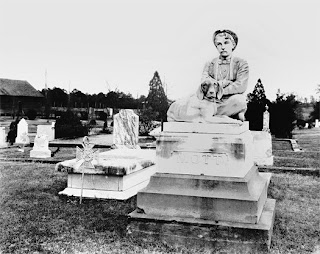







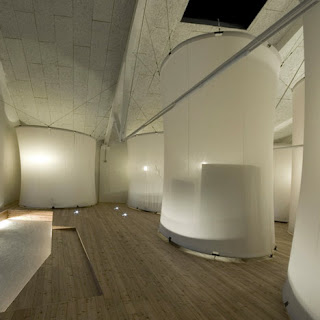












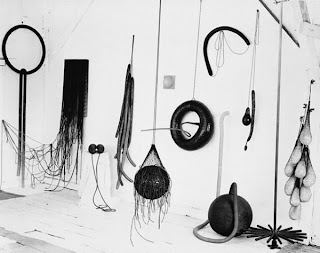




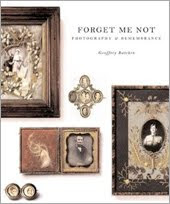




+.jpg)


.jpg)





